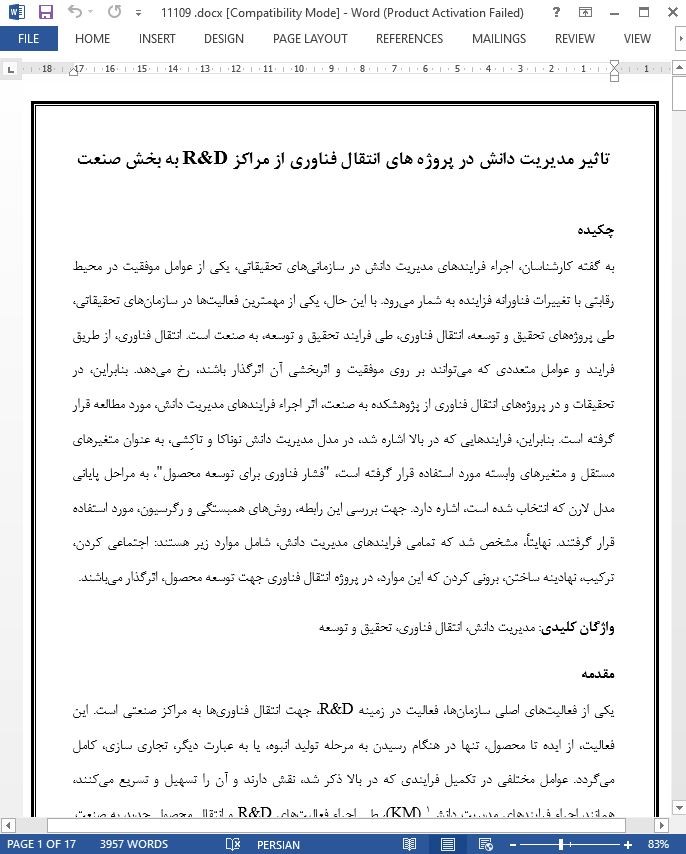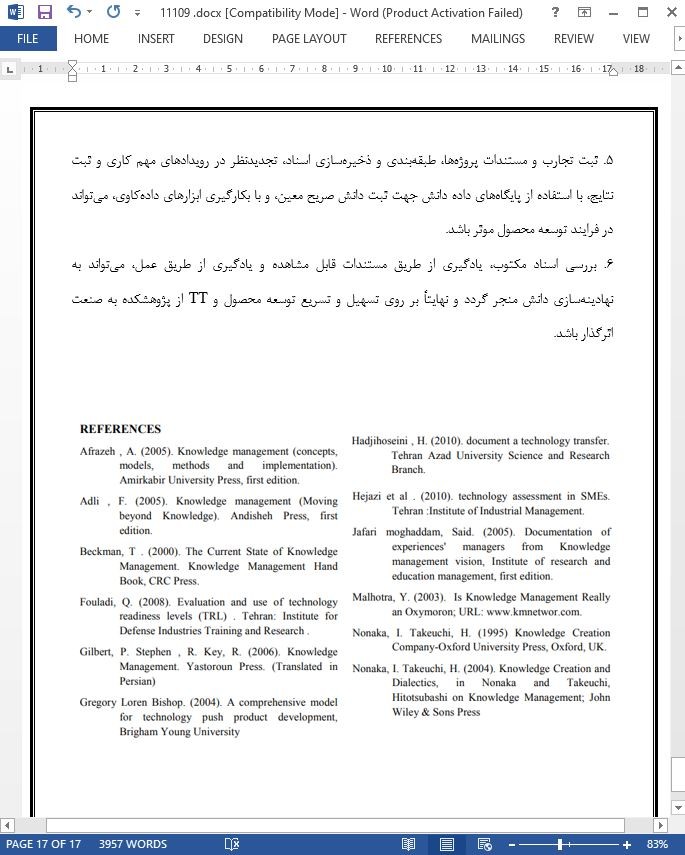
تاثیر مدیریت دانش در پروژه های انتقال فناوری از مراکز R&D به بخش صنعت
چکیده
به گفته کارشناسان، اجراء فرایندهای مدیریت دانش در سازمانیهای تحقیقاتی، یکی از عوامل موفقیت در محیط رقابتی با تغییرات فناورانه فزاینده به شمار میرود. با این حال، یکی از مهمترین فعالیتها در سازمانهای تحقیقاتی، طی پروژههای تحقیق و توسعه، انتقال فناوری، طی فرایند تحقیق و توسعه، به صنعت است. انتقال فناوری، از طریق فرایند و عوامل متعددی که میتوانند بر روی موفقیت و اثربخشی آن اثرگذار باشند، رخ میدهد. بنابراین، در تحقیقات و در پروژههای انتقال فناوری از پژوهشکده به صنعت، اثر اجراء فرایندهای مدیریت دانش، مورد مطالعه قرار گرفته است. بنابراین، فرایندهایی که در بالا اشاره شد، در مدل مدیریت دانش نوناکا و تاکِشی، به عنوان متغیرهای مستقل و متغیرهای وابسته مورد استفاده قرار گرفته است، "فشار فناوری برای توسعه محصول"، به مراحل پایانی مدل لارن که انتخاب شده است، اشاره دارد. جهت بررسی این رابطه، روشهای همبستگی و رگرسیون، مورد استفاده قرار گرفتند. نهایتاً، مشخص شد که تمامی فرایندهای مدیریت دانش، شامل موارد زیر هستند: اجتماعی کردن، ترکیب، نهادینه ساختن، برونی کردن که این موارد، در پروژه انتقال فناوری جهت توسعه محصول، اثرگذار میباشند.
مقدمه
یکی از فعالیتهای اصلی سازمانها، فعالیت در زمینه R&D، جهت انتقال فناوریها به مراکز صنعتی است. این فعالیت، از ایده تا محصول، تنها در هنگام رسیدن به مرحله تولید انبوه، یا به عبارت دیگر، تجاری سازی، کامل میگردد. عوامل مختلفی در تکمیل فرایندی که در بالا ذکر شد، نقش دارند و آن را تسهیل و تسریع میکنند، همانند اجراء فرایندهای مدیریت دانش (KM)، طی اجراء فعالیتهای R&D و انتقال محصول جدید به صنعت. به گفته کارشناسان، اجراء km، یکی از عوامل اصلی موفقیت و شکست در تجاری سازی محصولات و تولید انبوده به شمار میرود. این تحقیق، در تلاش برای مطالعه اثرات فرایندهای km در فرایندهای انتقال فناوری از یک مرکز R&D مشخص، به صنعت است. این امر، تنها از طریق مروری بر ادبیات km و حوزه مدیریت فناوری، طراحی چارچوب مفهومی تحقیقاتی و نهایتاً آزمون فرضیه، تحقق مییابد.
نتیجهگیری و پیشنهادات
1. اجراء کامل و بی عیب و نقص فرایندهای KM، منجر به فرایند موفق TT از پژوهشکده به صنعت میگردد.
2. با استفاده از آزمایشات و فعالیتهای انجام شده در فرایند توسعه محصولات، میتوان به پژوهشکده در این مسیر کمک کرد، و آنها را در زمینه اشتباهات گذشته و کاهش خطرات و وقت گیر بودن فرایند توسعه محصول مطلع ساخت.
3. برگزاری جلسات گروهی، سمینارهای تخصصی، نشستهای حل مسائل و نشستهای دورهای در قالب انجمنهای دانش، به تسهیل مرحله اجتماعی کردن توسعه محصول و TT از پژوهشکده به صنعت، کمک شایانی میکند.
4. مصاحبههای تخصصی، گفتگوهای درون گروهی و بکارگیری سیستم پرسش و پاسخ، میتواند منجر به برونی کردن دانش و تبدیل دانش ضمنی به دانشی مدون در نیروکار پروژههای TT شود.
ABSTRACT
According to experts, implementation of knowledge management processes in research organizations is one of the success factors in a competitive environment with increasing technological change. But in research organizations, one of the main activities during research and development projects is to transfer acquired technology during the process of research and development to industry. This technology transfer happens through a process and various factors can be effective on it’s success and effectiveness. Therefore, in the research, impact of implementation of knowledge management processes in technology transfer projects from institute to industry were studied. Therefore, the above-mentioned processes in Nonaka and Takeuchi 's model of knowledge management were used as independent variables and the dependent variable " technology pressure for product development " referred to in the final stages Lauren model is selected. To investigate this relationship, correlation and regression methods were used. Eventually it became clear that all knowledge management processes include: socialization, combination, internalization, externalization on phase of technology transfer project in product development is effective.
PREFACE
One of the main activities in organizations, working in the field of R&D, is to transfer the acquired technologies to industrial centers. This activity, from idea to product, is completed just when reaching to the phase of mass production and in other words, it is commercialized. Different factors can influence in completion of above-mentioned process and make it easy and fast such as implementation of knowledge Management (KM) processes during the execution of R&D activities and new product transfer to industry. According to the experts, km implementation is among main factors of success and failure in making a product commercialized and mass produced. In this research it is tried to study the impacts of km processes on technology transfer processes from one specific R&D center to industry. This job is done through literature review of km and domain of management of technology, research conceptual framework design, and finally testing hypotheses.
CONCLUSION AND SUGGESTIONS
1. Perfect and flawless implementation of KM processes can lead to successful TT process from institute to industry.
2. Using experiences and activities conducted in products development process can help institute in this way, and informs about the past mistakes , and makes products development process less risky and time consuming.
3. Holding group meetings, specialized seminars, brainstorming sessions and and periodic meetings in shape of knowledge societies can facilitate phase of socialization of product development and TT from institute to industry.
4. Specialized interviews, intragroup dialogues and using question and answer systems can conduce to knowledge externalization and converting tacit knowledge to codified knowledge in workforce of TT projects.
چکیده
مقدمه
مبانی نظری
تعریف دانش
Km و فرایندهای آن
فرایند R&D
انتقال فناوری در پروژههای R&D
روششناسی
فرضیات تحقیق
روش تحقیق
جامعه آماری و تعداد نمونهها
یافتههای تحقیق
نتیجهگیری
نتیجه فرضیه اول
نتیجه فرضیه سوم
نتیجه فرضیه چهارم
نتیجهگیری و پیشنهادات
ABSTRACT
PREFACE
THEORETICAL FOUNDATIONS
Knowledge Definition
Km and its processes
R&D process
Technology transfer in R&D projects
METHODOLOGY
Research conceptual framework
Research hypotheses
Statistical population and number of samples
Research methodology
RESEARCH FINDINGS
Test results
CONCLUSION
Conclusion of the first hypothesis
Conclusion of the first hypothesis
Conclusion of the third hypothesis
Conclusion of the fourth hypothesis
CONCLUSION AND SUGGESTIONS
- اصل مقاله انگلیسی با فرمت ورد (word) با قابلیت ویرایش
- ترجمه فارسی مقاله با فرمت ورد (word) با قابلیت ویرایش، بدون آرم سایت ای ترجمه
- ترجمه فارسی مقاله با فرمت pdf، بدون آرم سایت ای ترجمه



